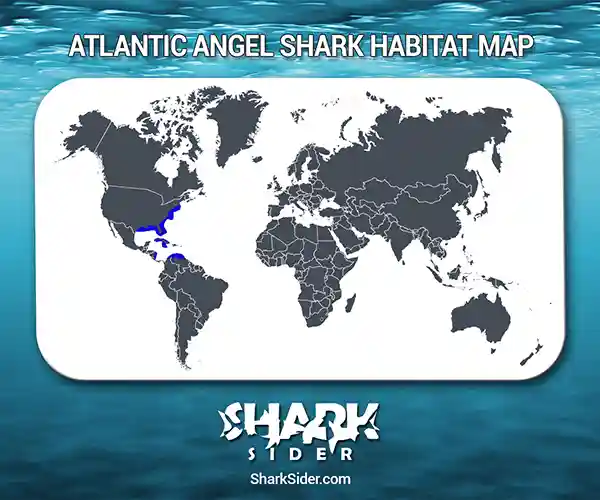Atlantic angel sharks are a bottom-dwelling species of angel sharks belonging to the genus Squatina. They dwell in sandy bottoms of the northwest Atlantic Ocean, which is why they’re also called sand devils.
These sharks were first described by French naturalist Charles Alexandre Lesueur, who named the shark in honor of André Marie Constant Duméril, a French zoologist. Lesueur published his findings in the Journal of the Academy of Natural Sciences of Philadelphia published in 1818 based on his research on a 3.9 ft. adult male. Some other common names by which this shark is known as are-angel shark and monkfish.
Tope Shark Scientific Classification |
|
| Kingdom | Animalia |
| Phylum | Chordata |
| Class | Chondrichthyes |
| Order | Squatiniformes |
| Family | Squatinidae |
| Genus | Squatina |
| Scientific Name | Squatina dumeril |
Description
Atlantic angel sharks are a small species of angel sharks with an average body size of 3-4 ft. The biggest ever recorded specimen of the Atlantic angel shark is 5 feet. They weigh around 35 lbs.
The upper body surface appears bluish-gray or ash-gray, with white undersides. There is a reddish tint on their head and some parts of the fin. Red spots are arranged haphazardly on their throat and abdomen and may be present all over their dorsal side.
The head and body of these sharks are significantly flattened, with skin folds on their sides that give an appearance of ray fishes. Their head consists of a wide terminal mouth and large eyes, with prominent spiracles behind. Each side of their head even has five pairs of gill slits. Another prominent feature of these sharks is the thin, pointed barbels with margins appearing smooth or a little fringed.
Their upper jaw has ten teeth, and the lower jaw has eighteen teeth on each side. The conically-shaped teeth are broad at the base and smooth towards the edge.
Atlantic angel sharks have a distinctive pair of expanded pectoral fins that resemble a triangular lobe. It is separate from the head in the front and consists of narrow tips on its rear. They have a pair of small and equal-sized dorsal fins around their tail. The upper lobe of the caudal fin is smaller than the other.
These fishes have a unique band of thorns on their back, ranging from the back of their neck to the caudal peduncle. The dorsal side of their body has conical dermal denticles with a broad base, slightly recurved. The denticles near their eyes are bigger arranged in clusters of five or six.
Where do they live
Map Of The Atlantic Angel Shark’s Habitat

A native of the Atlantic Ocean, the sand devils, are found in Massachusetts, the northern Gulf of Mexico, parts of the Caribbean, and in Columbia (Northern South America).
In the U.S., they are seasonal migrators, known to inhabit depths of 115ft during summer and swim to inshore waters deeper than 300 ft. during fall, winter, and spring. These sharks dwell in depths of 131-820 feet in northern parts of its distribution, whereas they’re found in depths of 4232 feet in the southern waters.
They’re bottom dwellers primarily buried in the sand on ocean floors.
Behavior
Dietary
They are adept at hiding and camouflaging itself to ambush prey by keeping itself buried in the sand. They primarily feed on bottom-dwelling, ray-finned fishes like croakers, goatfishes, and butterfishes. Smaller-sized Atlantic angel sharks prefer squids and sometimes crabs, skates, and bivalves.
These sharks are active throughout the day and night, thus feeding always. They tend to select their prey which is about half the size of their mouth, to yield the maximum energy from the prey.
Sand devils in the northern Gulf of Mexico prefer fishes like the Atlantic croaker, long spine porgy, spot croaker, Gulf butterfish, red and dwarf goatfishes, and the longfin inshore squid.
The preference for feeding changes according to the seasonal availability of prey.
Reproductive
Atlantic angel sharks follow a viviparous mode of reproduction where eggs are present in the form of enclosed capsules in the uterus, where they eventually hatch. Inside the egg, the embryos are sustained by the yolk. Mating occurs around spring and involves behavior where the males hold on to the back of the females to aid in copulation. Although females have two functional uteri and a single functioning ovary, they reproduce not more than once in a couple of years.
Litter size consists of 16-25 pups (each measuring 9.8-11.8 in), which emerge from February-June following roughly a year of gestation. Birthing occurs at depths of roughly 66-98 feet. Males and females reach the stage of sexual maturity when they are 37 and 34 inches long, respectively.
Adaptations
Unlike other bottom-dwelling sharks and fishes, these sharks follow a unique respiratory mechanism. They utilize the gill flaps on their sides to pump out the water instead of their oropharyngeal cavity. They have adopted this mechanism to prevent themselves from being noticed by predators while buried in the sand.
The spotted coloring on their body also helps them camouflage to the ocean floor and lets them go undetected.
Interactions with humans
The Atlantic angel shark is not aggressive unless provoked, although it can be severely dangerous when not handled carefully. There have been several cases of fishermen and divers getting bitten when they tried to restrain these sharks.
In the Gulf of Mexico waters, thy are seldom caught by bottom trawls as bycatch. Although they have no primary commercial importance, their meat (which is edible) is sometimes sold in the market. The IUCN has listed the Atlantic angel shark as “Least Concern”.
